Essential Guide to Extra Large Parakeet Cages
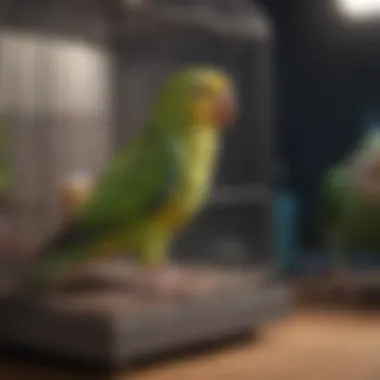
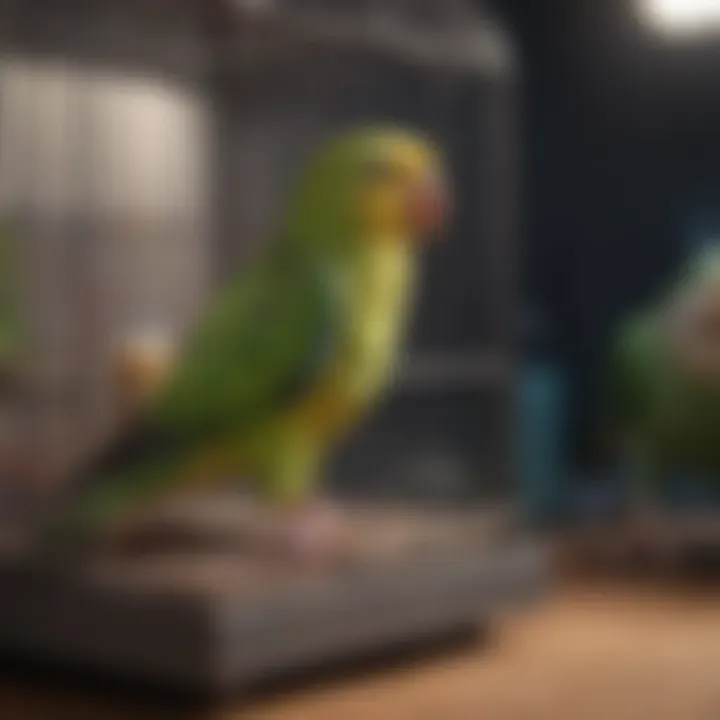
Intro
Choosing the right cage for a parakeet is not just about aesthetics or cost; it is fundamentally about the bird’s health and overall quality of life. Extra large parakeet cages provide essential space that allows these frolicsome creatures to thrive. In this article, we explore various factors crucial to understanding why larger enclosures are needed, as well as the specific features that enhance the living environment for parakeets. From care practices to behavioral insights and nutrition guides, each aspect plays a vital role in shaping the parakeet’s well-being.
Care Tips
Daily Care Routines
Establishing a consistent daily care routine is essential. Parakeets are social animals and benefit from regular interaction. Spend time each day talking to them and observing their behavior. Ensure they have fresh water and food daily.
Cage Setup and Maintenance
An extra large cage will require strategies for maintenance. This often includes rearranging toys, perches, and food bowls to keep their environment fresh and engaging. Position the cage in a quiet but interactive area of your home for a balance of socialization and tranquility.
Hygiene and Cleaning Practices
Maintain hygiene by cleaning the cage frequently. Waste buildup can lead to bacterial growth, which affects your bird's health. Use bird-safe cleaning solutions. Pay attention to corners and under perches where debris accumulates.
Seasonal Care Adjustments
With changing seasons, parakeets may require adjustments in their care. During colder months, ensure they are warm enough and avoid drafts in their area. In summer, be cautious of heat; avoid direct sunlight and provide cooling options.
Behavioral Insights
Understanding Bird Body Language
Parakeets communicate a lot through their body language. Learning the signs can enhance your understanding of their emotional states. Fluffed feathers often indicate comfort, while a lowered head can signify submission or fatigue.
Common Behavioral Issues and Solutions
Common issues include excessive screeching and feather plucking. Identifying the causes of these behaviors, such as boredom or stress, is important. Solutions include providing more engaging toys or more social interaction.
Positive Reinforcement Techniques
When training parakeets, positive reinforcement is effective. Offering treats or praise for desired behavior encourages them to repeat those actions. This builds trust and strengthens the bond between bird and owner.
Social Interaction Needs
Parakeets thrive in social settings, whether it's with humans or other birds. If you have a lone bird, consider adopting a companion. Make sure to observe their interactions to ensure compatibility.
Nutrition Guides
Essential Diet Components
A balanced diet is vital for the health of your parakeet. Seed mixes should be the base, supplemented with pellets, fruits, and vegetables to provide necessary nutrients. Your bird should have a varied diet to ensure they receive essential vitamins.
Safe and Toxic Foods
Certain foods are safe for parakeets, such as apples and carrots. However, avoid avocados, chocolate, and caffeinated products, as they are toxic to birds. Familiarize yourself with food safety to prevent health risks.
Supplements and Treats
Consider adding calcium supplements if your bird’s diet lacks calcium sources. Choose treats wisely, as they should be given in moderation to prevent obesity.
Feeding Strategies for Different Species
Different parakeet species may have unique dietary needs. Research specific requirements for your parakeet to optimize their nutritional intake.
Wellness and Health
Routine Health Checkups
Regular visits to an avian veterinarian are crucial. These checkups can catch potential health issues early. Monitor your bird’s health by watching for changes in behavior or appearance.
Identifying Symptoms of Illness
Know the common symptoms of illness, such as lethargy or changes in appetite. A drop in vocalization can also indicate discomfort.
Preventative Care and Vaccinations
Preventative care is essential in bird ownership. Vaccinations can help protect against common diseases. Discuss vaccination schedules with your veterinarian.
Mental and Emotional Well-being
It's vital to support not only the physical health of your parakeets but also their emotional health. Providing a stimulating environment is key.
Enriching Activities
Toys and Playtime Ideas
Incorporate various toys into the cage. Rotate them regularly to keep your bird interested. Use perches that are varied in texture and size to stimulate their feet.
Training and Tricks
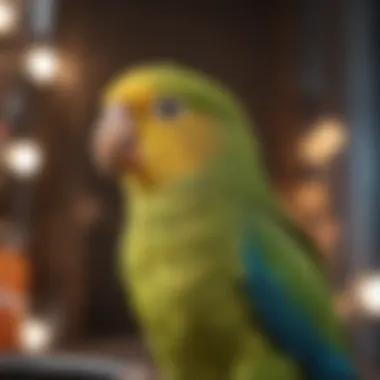
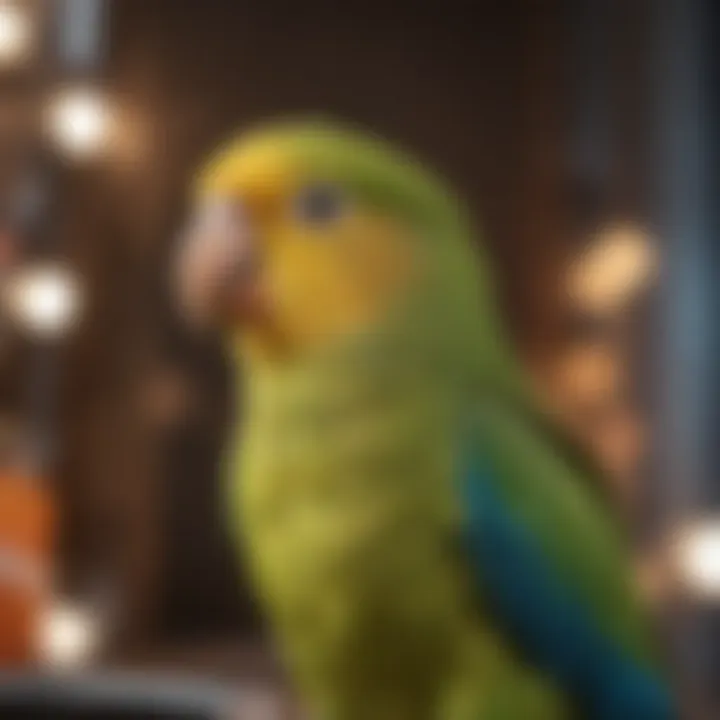
Training your parakeet to perform simple tricks is rewarding. It builds a bond and satisfies their intelligence. Use gentle methods and be patient.
Outdoor Activities and Interaction
When the weather permits, consider outdoor playtime. Always supervise your bird closely to avoid accidents. Use harnesses designed for birds to ensure safety.
DIY Projects for Mental Stimulation
Engage your parakeet’s mind with DIY projects. Simple tasks like paper shredding or creating foraging toys can provide amusement and challenge.
Creating an engaging environment for your parakeet is essential for their overall well-being. Larger cages can accommodate more toys and perches, enhancing their lifestyle.
Prelude to Extra Large Parakeet Cages
Understanding the significance of extra large parakeet cages is vital for any bird owner. These cages serve as more than just habitats; they are essential ecosystems that promote the health and happiness of parakeets. Choosing the right cage can have profound effects on a bird's well-being, behavior, and overall quality of life.
Extra large cages provide ample space for parakeets to move, explore, and exercise. These birds are naturally active and curious creatures that thrive in environments that mimic their native habitats. Without sufficient space, parakeets can experience stress and become less social, leading to behavioral problems.
When considering an extra large cage, owners should reflect on several key elements. The dimensions of the cage must accommodate not just the size of the bird but also its need for space to fly and play. A larger cage encourages proper physical development and diminishes the risk of obesity, common in domesticated birds with restricted movement.
Moreover, the cage should be structured to include various elements that enhance the bird's environment. Perches, toys, and feeding stations should be thoughtfully arranged to foster engagement and mental stimulation. Understanding what features to consider in design and materials can help optimize the living space for parakeets.
Additionally, there are practical benefits to larger cages. Owners will find it easier to manage cleaning and maintenance tasks when there is enough room to navigate inside the cage. This could result in a healthier environment for their feathered companions.
Overall, the choice of an extra large parakeet cage is integral in creating a nurturing home. It ensures that bird owners meet the physical and emotional needs of their pets, ultimately leading to happier and more vibrant parakeets. This introduction lays the groundwork for understanding critical aspects such as space requirements, materials, and design features that will follow in-depth in the subsequent sections.
Understanding Space Requirements
When it comes to caring for parakeets, understanding the spatial needs of these birds is fundamental. Choosing the right cage size is not just a matter of aesthetics; it directly impacts their overall health and well-being. An extra large cage provides ample room for your parakeet to move, play, and engage in natural behaviors. This section will explore the importance of space, its implications on your bird's behavior and health, and necessary considerations for determining the appropriate cage size.
Determining the Minimum Cage Size
To determine the minimum cage size for parakeets, several factors come into account. The general guideline suggests that the minimum dimensions for a small parakeet should be at least 30 inches long, 18 inches wide, and 18 inches high. However, extra large cages allow for a more comfortable environment, supporting various activities.
- Bird Activity Level: More active species may require larger cages. Budgerigars, for example, love to jump and fly short distances, so more space is beneficial.
- Number of Birds: If you plan to house more than one bird, ensure that the cage is big enough for all occupants to claim their own space without feeling crowded.
- Flight Space: Consider the space for horizontal and vertical movement. The added height can encourage climbing and play, which is essential for their mental health.
It’s important not to underestimate the emotional benefits a spacious cage provides. An extra large cage not only promotes physical activity but also boosts confidence in birds, making them more social and interactive.
Behavioral Implications of Space
Behavioral patterns in parakeets are greatly influenced by their living conditions. A cramped environment can lead to stress, aggression, and boredom. Here are some behavioral implications to keep in mind:
- Stress Reduction: An adequate space reduces the likelihood of territorial disputes among multiple birds, which can lead to injuries or increased anxiety.
- Exploration and Enrichment: Extra large cages allow opportunities for exploration. Birds engage in purposeful movements, exploring various perches and toys. This exploration helps maintain their cognitive health.
- Social Interactions: Birds are social creatures. Having ample space facilitates more natural interactions. They can choose to be near each other or have distance when needed, which is critical for their happiness.
"A spacious cage is not just a luxury; it is a necessity for promoting harmonious and healthy living for parakeets."
In summary, understanding the space requirements for parakeets impacts more than just their physical comfort. It significantly enhances their quality of life. When determining the ideal cage size, prioritize not only the size but also the layout to promote a stimulating environment for your feathered companions.
Key Features of Extra Large Parakeet Cages
When considering the wellbeing of parakeets, the choice of cage holds great weight. Extra large parakeet cages are not merely spacious containers; they are vital in meeting the specific needs of these intelligent and social birds. A well-designed cage can foster a healthy environment, support behavioral habits, and offer a safe haven. Below are crucial features to evaluate when selecting a suitable cage for parakeets.
Material Considerations
Metal vs. Plastic
Metal cages are often favored over plastic options for several reasons. A significant advantage of metal is its durability. Metal cages tend to withstand the chewing and scratching that can occur with active parakeets. On the other hand, plastic cages may break or degrade over time. Metal cages also make it less likely for parakeets to escape. An often-cited disadvantage is that metal can be heavier and more challenging to move, particularly larger models. However, stainless steel or powder-coated finishes can mitigate rust and corrosion, adding to the longevity of the cage.
The choice between metal and plastic ultimately comes down to one’s priorities regarding safety and durability.
Non-toxic Finishes
Choosing the right non-toxic finishes is essential. Birds are sensitive to various chemicals, and their health can be compromised by harmful substances. Non-toxic finishes not only safeguard the bird but also contribute significantly to the overall aesthetic of the cage. Many cages come with finishes that are free from harmful coatings like lead or zinc. Such finishes remain essential for ensuring a safe environment.
While the surface may be visually appealing, potential downsides include the wear of the finish over time, especially in high-usage areas. Being diligent during maintenance is crucial to ensure these finishes hold up well against wear and tear.
Design Elements
Bar Spacing and Configuration
Bar spacing is vital for ensuring the safety of parakeets within their cage. The correct spacing prevents small birds from escaping or getting their heads stuck. Often, a spacing of around half an inch is appropriate for parakeets. Moreover, the configuration, such as vertical and horizontal bars, can encourage climbing and physical activity. This aspect of design is not just about safety; it also promotes a more engaging environment for the birds.
In contrast, improper bar spacing could lead to injuries. Therefore, paying attention to these details is crucial when creating a secure environment.
Access and Convenience
Door Types
Various door types play a significant role in how easily you can interact with your parakeets. Larger doors facilitate easier access for cleaning and handling, which is essential for owner interaction and regular maintenance. Some cages offer multiple entry points, which can enhance accessibility. Many pet owners prefer sliding or swing doors, as they provide options for different types of access. However, it's essential to ensure these doors have secure locks to prevent escapes.
Ease of Cleaning
Cleaning routines are a reality of bird ownership. Therefore, ease of cleaning should be a top priority when selecting a cage. Cages that come with removable trays or easy-to-access perches make maintenance straightforward and efficient. A clean environment is vital for the health of your parakeet, as it prevents the buildup of waste and bacteria. If cleaning requires excessive time and effort, it may lead to neglect, which is detrimental to your pet’s well-being.
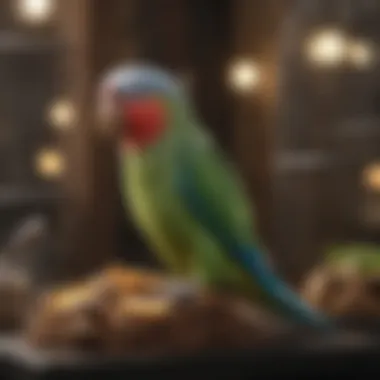
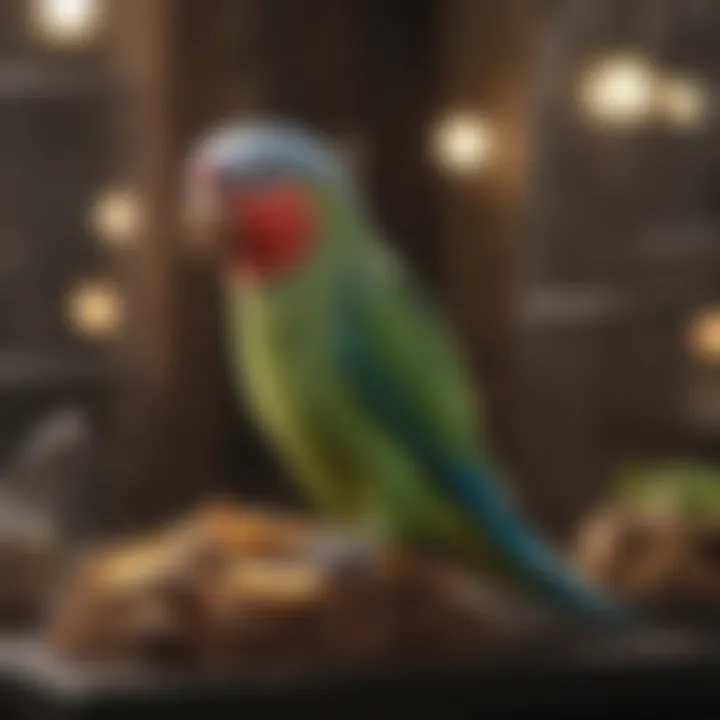
Placement of the Cage in the Home
The placement of the cage plays a critical role in the health and happiness of parakeets. The location not only affects the comfort of the bird but also significantly impacts its socialization and interaction with the environment. A well-placed cage can contribute towards creating a balanced ecosystem for the pet, allowing it to thrive. Speaking to specifics, consideration of factors such as light, noise, and safety must be accounted for when deciding where to put the cage.
Ideal Locations
When deciding the best location for an extra large parakeet cage, some fundamental areas come to mind. A living room or family area is often ideal, as it allows for regular interaction and observation. Parakeets are social creatures and will benefit from being part of daily activities. Another suitable location might be near a window, ensuring that the bird has access to natural light, but precautions need to be taken to avoid direct sunlight.
- Visibility: Position the cage where it can be easily seen and accessed. This encourages interaction and bonding between the bird and its owner.
- Social Environment: Parakeets enjoy being part of the household and will thrive in an area where they can engage with family members.
- Natural Light: A well-lit area can enhance the bird's mood and activity levels.
Avoiding Hazards
Direct Sunlight
Direct sunlight can be harmful for parakeets. While birds need light, excessive exposure to direct sunlight can cause stress and overheating. It is essential to find a balance by allowing indirect sunlight into the cage without exposing the bird to harsh rays.
- Key Characteristic: The harmful effects stem from UV rays which can cause overheating and dehydration.
- Consideration: Strategically orient the cage in such a way that it can receive ambient light while avoiding spots where the sun rays are direct during peak hours.
- Advantages/Disadvantages: Acknowledge that while some sunlight is beneficial, careful planning is needed to prevent any negative effects.
Toxic Plants
Toxic plants pose a significant risk for parakeets. Many common houseplants can be harmful to birds if ingested. Knowing which plants to avoid is crucial for creating a safe environment.
- Key Characteristic: Certain plants like pothos, philodendrons, and oleander are known to be toxic to birds.
- Consideration: Carefully assess your home for any existing plants that may have harmful effects on parakeets.
- Advantages/Disadvantages: While plants can beautify a space, prioritizing the safety of your pet is essential. Removing or relocating toxic plants can create a more secure environment.
"Placement of the cage directly influences the psychological well-being of your pet parakeet."
In summary, finding the right place for an extra large parakeet cage is about balancing visibility, safety, and comfort. Thoughtful consideration helps ensure a healthy and engaging environment for feathered companions.
Maintaining a Clean Environment
Maintaining a clean environment is essential for the health and well-being of parakeets. A clean cage prevents the spread of diseases, keeps odors at bay, and creates a more pleasant living space for both birds and their caregivers. Cleanliness directly impacts a parakeet's physical health and mood, as a dirty environment can lead to stress and anxiety. Proper care routines and waste management strategies must be established to ensure the parakeets live in a sanitary habitat.
Daily Care Routines
Daily care routines are crucial for keeping the cage environment clean. This involves regular tasks such as removing soiled food and water dishes, freshening up the bedding, and wiping down surfaces. A daily inspection of the cage is also necessary. During these inspections, caregivers can look for signs of illness or discomfort in their birds.
It is important to establish a consistent routine, as parakeets thrive on predictability. By setting aside time each day for these tasks, owners can promote a healthier living space and foster a bond with their pets.
Dealing with Waste
Types of Bedding
The choice of bedding plays an important role in maintaining a clean environment. Common types of bedding include paper-based bedding, aspen shavings, and coconut fibers.
Paper-based bedding is often regarded as a popular option because it absorbs moisture well and is easy to replace. Its lightweight nature makes cleaning hassle-free. Some owners prefer aspen shavings, which are also absorbent and provide a natural appearance within the cage. However, care must be taken to avoid cedar or pine bedding, which can emit harmful oils.
Bedding needs to be changed regularly, typically once a week, to prevent the buildup of waste and bacteria. A good bedding choice minimizes odors and keeps the environment hygienic.
Disposal Methods
Disposal methods for waste materials are another aspect of maintaining cleanliness. It is vital for caregivers to choose eco-friendly and practical disposal methods.
Most bird owners find using compostable options like paper bedding beneficial, as it reduces environmental impact and provides a sustainable solution. Regular collection of droppings and disposal in sealed bags can also help control odors. Some owners may opt for clean-up tools like vacuums specifically designed for bird care to make the process easier.
Implementing effective disposal methods keeps the cage neat and reduces health risks associated with waste accumulation.
Enrichment for Parakeets in Large Cages
Enrichment is crucial for parakeets to maintain their physical and mental well-being. In large cages, parakeets have more space to explore, allowing them to express natural behaviors. This is essential because parakeets are intelligent and social creatures. Adequate enrichment can prevent boredom, promote fitness, and enhance overall quality of life.
Types of Enrichment Items
Perches and Toys
Perches and toys are foundational elements of enrichment. They provide places for parakeets to sit, exercise, and engage in play. Natural wood perches are often preferred over plastic ones due to their texture and grip. This enhances foot health and offers a more natural environment. Toys, on the other hand, allow for interaction and stimulation. They come in various materials and designs, including chew toys and foraging toys.
The key characteristic of perches and toys is that they encourage movement and curiosity. This is a beneficial choice as it stimulates mental activity and physical exercise, both necessary for a healthy parakeet. However, it is important to rotate these items regularly to keep the environment interesting and engaging. Over time, certain toys may become worn or stale, reducing their effectiveness in capturing the bird’s attention.
Food Dispensers
Food dispensers add another layer of enrichment. These devices allow parakeets to work for their food. This mimics hunting and foraging behaviors, making mealtime a rewarding experience. The most common types are hanging dispensers and foraging puzzles. They come designed to challenge birds mentally while providing nutrition.
The key characteristic of food dispensers is that they promote natural feeding behaviors. They encourage the birds to be active and engage with their environment, which is essential for preventing obesity and behavioral issues. While food dispensers are generally advantageous, they should be used with caution. Some parakeets might become frustrated if the challenge is too difficult, so selecting appropriate dispensers for your bird’s skill level is necessary.
Creating an Engaging Layout
To maximize the benefits of enrichment items, how the cage is organized plays a distinct role. It is important to design the cage layout strategically. This can include placing multiple perches at various heights and spacing toys throughout the cage. The goal is to create an environment that fosters exploration. Each area should encourage different activities, maintaining the parakeet's interest and promoting active movement within its habitat.
Species-Specific Considerations
When selecting extra large cages for parakeets, it is crucial to consider the specific needs of different parakeet species. Each species has unique behaviors and physical characteristics that significantly affect their living environment. Recognizing these differences helps in promoting their overall health, comfort, and happiness in captivity.
Tailoring for Different Parakeet Species
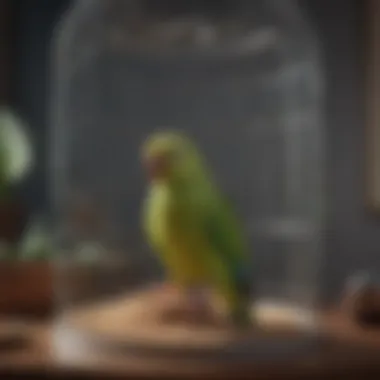
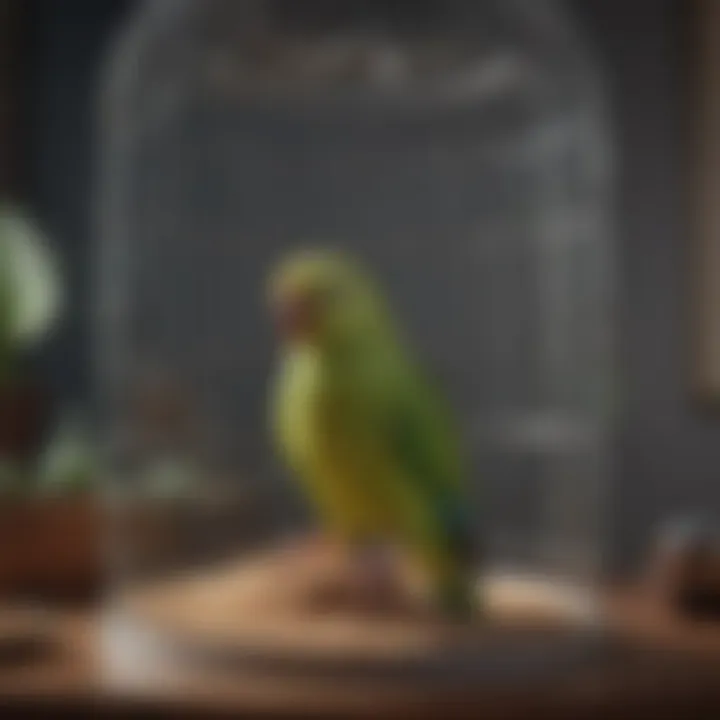
Budgerigars
Budgerigars, commonly known as budgies, are one of the most popular pet birds. Their small size and social nature make them favored among bird owners. An ideal extra large cage for budgerigars should provide ample space for flying and climbing.
A notable characteristic of budgies is their playful behavior and need for social interaction. They thrive in environments where they can move freely and engage with toys and other budgies. This contributes to a balanced life, fostering mental stimulation and physical health.
However, it is essential to consider their social behaviors when choosing a cage. Budgerigars do best in pairs or small groups, so an adequately sized cage is necessary to accommodate multiple birds comfortably, ensuring they have enough space to avoid territorial disputes.
Lovebirds
Lovebirds are known for their strong bond with their companions, be it other lovebirds or their human caretakers. This species requires a cage that supports their affectionate nature and active lifestyle. Their inquisitive behavior demands an environment that allows for exploration and play.
An interesting feature of lovebirds is their robust physicality. They can be more active than budgies, requiring sturdy perches and toys that can withstand their lively antics. Selecting an extra large cage with diverse levels and spaces for climbing enhances interactivity and enriches their daily life. However, it is critical to monitor their compatibility since lovebirds can become territorial, necessitating space to reduce stress.
Others
Apart from budgerigars and lovebirds, many other parakeet species require specific considerations when selecting a cage. Species like cockatiels or conures, while not technically parakeets, share similar needs. They generally benefit from large cages that promote movement and socialization.
These birds often have distinct vocalizations and behaviors that can influence their living conditions. Certain species, like the Quaker parakeet, are known for their strong, complex behaviors and emotional needs. Providing a spacious cage tailored to these characteristics allows them to thrive while minimizing behavioral issues.
Moreover, unique dietary requirements and compatibility between mixed species in one cage should be considered. Selecting appropriate cage mates or ensuring a spacious environment for solo dwellers enhances the overall living experience.
Conclusion: Recognizing the species-specific needs of parakeets validates the importance of extra large cages. Tailoring the environment according to the unique traits of each species ensures a beneficial habitat, fostering both well-being and happiness.
Communication and Interaction
Effective communication is crucial to the overall well-being of parakeets. A major component of this interaction is understanding vocalization. Parakeets are social creatures, and their vocalizations serve multiple purposes. They communicate their feelings, needs, and even establish social hierarchies through sounds. Recognizing distinct vocalizations can greatly enhance the bond between a bird and its owner. Understanding when a parakeet is happy or stressed enables owners to respond accordingly and create a more harmonious living environment.
Additionally, interaction goes beyond mere communication. The act of engaging with parakeets fosters trust. Birds learn to recognize their owners, which can lead to more comfortable and safe experiences. Regular interaction can also encourage vocalization, as parakeets often mimic sounds they hear frequently. In turn, this leads to a more robust social atmosphere, which is vital for their mental stimulation.
Understanding Vocalization
Vocalization in parakeets varies widely. Common sounds include chirping, whistling, and chattering. Each sound conveys a different emotional state or need. For instance, a loud squawk may indicate that a parakeet feels threatened, while soft chirps typically express contentment. By paying attention to these sounds, owners can better understand what their parakeets are experiencing.
Moreover, vocalization plays a role in the species’ social structure. Budgerigars are known to engage in complex vocal interactions within flocks. Mimicking these sounds helps domesticated birds feel connected to their surroundings. By fostering a communicative environment, owners can improve their birds' happiness and reduce stress.
Building a Bond
Establishing a bond with parakeets requires time and effort. Positive reinforcement is a crucial part of this process. The concept revolves around rewarding desired behaviors to encourage them. This method helps build trust between the owner and the bird. For example, giving a treat when a parakeet steps onto your finger fosters a sense of safety and cooperation. The key characteristic of positive reinforcement is that it provides immediate feedback. This aspect makes it a popular choice for training birds.
Positive Reinforcement
Positive reinforcement allows birds to make connections between actions and rewards. The major advantage is the reduction of stress. When parakeets experience positive interactions, their confidence increases. Therefore, they become more open to training. However, it is essential for owners to be consistent. Mixed signals can confuse the birds and hinder their development.
One unique feature of this method is that it can be customized. For instance, treats can vary according to each bird's preferences. Some parakeets might prefer seeds, while others may enjoy fruit. This flexibility enhances the training experience by making it enjoyable for the bird. Nevertheless, reliance on treats can also have drawbacks, such as overeating. Striking a balance is critical.
Hand-Training Techniques
Hand-training is another effective way to connect with parakeets. This method involves teaching birds to interact with their owner's hands. A key advantage of hand-training is that it familiarizes birds with human interaction. Birds that are comfortable with hands tend to exhibit less fear. Furthermore, this technique can be beneficial when needing to handle birds for grooming or health checks.
Hand-training techniques also vary. Using a gradual approach is often recommended. Start by letting the bird become comfortable with your hand without forcing it. As the bird grows accustomed, you can progress to guiding it onto your hand. This gradual exposure reduces anxiety and builds trust. One potential drawback is the time required. Patience is essential, as each bird learns at its own pace.
Cost Considerations for Extra Large Cages
Understanding the financial implications of owning an extra large parakeet cage is vital for bird owners. The initial purchase cost can be significant, and it often leads to ongoing expenses over the pet's lifetime. Knowing these costs in advance helps owners make informed decisions and prepares them for the long-term commitment of caring for their feathered companions.
Budgeting for the Initial Purchase
When considering an extra large cage, the upfront cost is an essential factor. These cages are generally more expensive than smaller options due to their size and construction materials. Prices can range from a few hundred to over a thousand dollars, depending on the quality and features.
Investing in a larger cage is beneficial. It provides adequate space for parakeets, encouraging their physical and mental well-being. A well-planned budget should factor in the variety of cages available. Researching brands and reviews will help in choosing a cage that offers the best balance between price and quality.
Long-Term Maintenance Costs
Once the initial cost is settled, long-term maintenance must be addressed. It includes ongoing expenses related to food, supplies, and veterinary care.
Food and Supply Costs
Food and supply costs constitute a significant part of long-term expenses. High-quality pellets, fresh fruits, and vegetables are essential for a balanced diet. The choice of diet directly impacts the health of parakeets. Typically, expect to spend around $20 to $50 monthly on food, depending on the brand and type.
In addition to food, regular purchases of items like bedding, toys, and perches are required. These items provide stimulation and comfort to parakeets. Ignoring these expenses can lead to detrimental effects on the birds' health and happiness. Therefore, including these costs in the budget is important to ensure a healthy living environment for the species.
Veterinary Care
Veterinary care is another ongoing cost to consider. Regular check-ups and vaccinations are essential for maintaining the health of parakeets. An annual visit to an avian vet can range between $50 and $150. While this may seem like a considerable expense, it is crucial for preventing potential health issues that can be more costly in the long run.
Additionally, unexpected health concerns may arise, leading to further expenses. Pet owners must set aside funds for emergencies, as health issues can develop suddenly and may require immediate attention.
"Being financially prepared for unexpected costs ensures that the health of your parakeet isn't compromised."
End
In summing up the necessity and features of extra large parakeet cages, it becomes evident that the right cage is pivotal for the health and happiness of these birds. The space provided in an extra large cage is not merely a luxury; it directly contributes to the behavioral stability and physical well-being of parakeets. When they have ample room to fly, climb, and explore, it reduces stress, encourages exercise, and minimizes feather-plucking and other related issues.
Considerations such as the cage material, design, and placement play crucial roles as well. A cage crafted from non-toxic materials ensures safety, while an appropriate design can enhance accessibility and ease of cleaning. Furthermore, the ideal placement of the cage within the home can significantly affect the parakeet's mood and health. Being around their human companions and away from hazards promotes a sense of security and encourages social interactions.
Enrichment options cannot be overlooked. A well-furnished cage with perches, toys, and food dispensers keeps parakeets engaged and mentally stimulated. This aspect underscores not just the quantity of space, but the quality of their environment.
The initial investment in an extra large cage is justified through the long-term benefits it provides. The costs associated with maintaining a proper living space and keeping the birds healthy can be mitigated when their needs are prioritized from the start. Thus, opting for larger cages can lead to better health outcomes and a more harmonious relationship between the birds and their owners.















